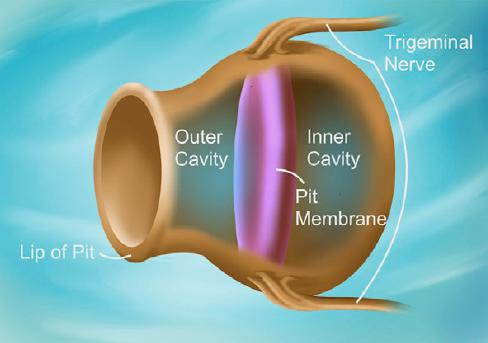Oct 22 2020
The conversion of heat into electricity is a property believed to be restricted only to crystals and other stiff materials.
 This image shows a rattlesnake’s pit organ. Image Credit: Darbaniyan et al./Matter.
This image shows a rattlesnake’s pit organ. Image Credit: Darbaniyan et al./Matter.
But now, motivated by the infrared (IR) vision of snakes, scientists have designed a mathematical model for transforming soft, organic structures into what is known as “pyroelectric” materials.
The study, which appeared in the Matter journal on October 21st, 2020, demonstrates that soft and flexible matter can be converted into a pyroelectric material and could resolve a long-standing mystery that surrounds the mechanism of IR vision in snakes.
When a material is able to convert heat into an electric impulse, it is known as “pyroelectric”—a property that is usually found only in strong and inflexible substances. But the enigma is how the heat-to-electricity conversion property is achieved by IR sensing snakes in spite of having naturally soft anatomy.
People thought we could explain the IR sensing of snakes if there was a hard, pyroelectric material in their pit organ, but nobody ever found one. So, we wondered whether just as we are trying to make these soft materials pyroelectric, maybe nature is doing the same thing.
Pradeep Sharma, MD, Anderson Professor and Chair of Mechanical Engineering, University of Houston
Numerous snakes, including pit vipers, similar to the aliens in the Predator series, are popular for their heat-sensing traits. As a matter of fact, pit vipers have such a highly sensitive IR vision that “if an animal appears in pitch black darkness, even for a half a second 40 centimeters away, the pit viper will be able to detect it,” added Sharma.
This potential is achieved by a structure known as a pit organ—a hollow chamber located next to the snake’s nostrils comprising a thin, flexible membrane.
The pit organ plays an important role in processing heat into a signal they can detect. However, the missing part of the equation was how the neuron cells within the pit organ membrane convert a heat signature into electricity to create that signal.
Pradeep Sharma, MD, Anderson Professor and Chair of Mechanical Engineering, University of Houston
Sharma and his team used the physiology of the pit organ membrane as inspiration and successfully built a mathematical model to describe how the heat-to-electricity conversion property could be achieved in a soft organic material.
Our solution is deceptively simple. Apart from more advanced design elements, to make a pyroelectric soft material all you need is to embed static, stable charges into the material and ensure they don’t leak out.
Pradeep Sharma, MD, Anderson Professor and Chair of Mechanical Engineering, University of Houston
Sharma added, “Then you must make sure the material is soft enough that it is capable of large deformation in shape and size and has a sensitivity to temperature. If you do that, they will act pyroelectric, and that’s what we’ve been able prove in our model. And we believe that’s what exactly nature is using because this process is simple and robust.”
Laboratory experiments performed using soft materials have already started to validate the model, although additional studies are still required to verify whether this suggested mechanism is occurring in the neuron cells found in the pit organ membrane of the snake.
Previous studies had implicated that TRPA1 protein channels situated inside the membrane’s neuron cells play a crucial role, but the relation of such protein channels to the suggested mechanism in the article is yet to be understood.
“Using this model, I can confidently create an artificial soft material with pyroelectric properties—of that there is no doubt. And we are fairly confident that we have uncovered at least part of the solution of how these snakes are able to see in the dark. Now that we’ve developed the model, other scientists can come forward and start doing the experiments to confirm or deny whether our theory about snake IR sensing is correct,” concluded Sharma.
Sharma has now planned to continue his study on the soft matter, investigating ways on how to exploit them to produce electricity only from a magnetic field. With sufficient research work, Sharma hopes to motivate the advancement of piezo, pyro, and magnetoelectric soft materials, thereby extending the possibilities of how humans produce electricity.
Journal Reference:
Darbaniyan, F., et al. (2020) Soft Matter Mechanics and the Mechanisms Underpinning the Infrared Vision of Snakes. Matter. doi.org/10.1016/j.matt.2020.09.023.